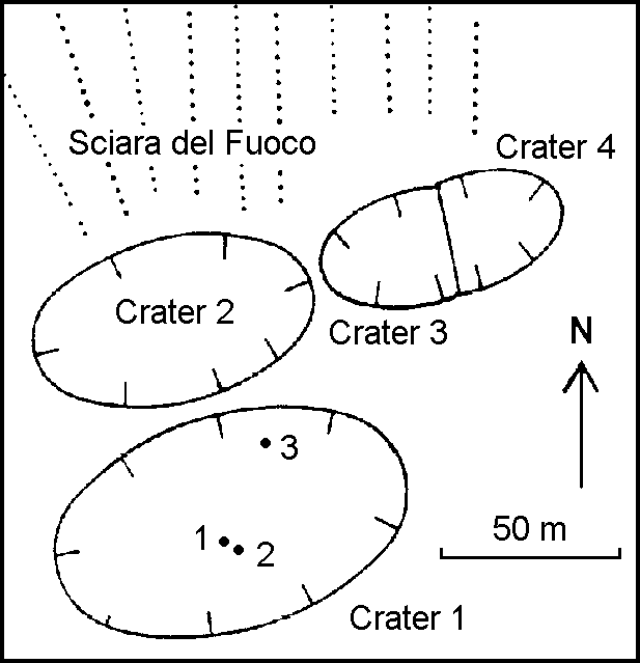Report on Stromboli (Italy) — November 1988
Scientific Event Alert Network Bulletin, vol. 13, no. 11 (November 1988)
Managing Editor: Lindsay McClelland.
Stromboli (Italy) Incandescent tephra from several vents
Please cite this report as:
Global Volcanism Program, 1988. Report on Stromboli (Italy) (McClelland, L., ed.). Scientific Event Alert Network Bulletin, 13:11. Smithsonian Institution. https://doi.org/10.5479/si.GVP.SEAN198811-211040
Stromboli
Italy
38.789°N, 15.213°E; summit elev. 924 m
All times are local (unless otherwise noted)
Geologists visited Stromboli in October and November. Surface temperatures associated with Strombolian and fumarolic activity were studied for comparison with remotely sensed data. Temperatures were recorded using a Minolta Cyclops 33 radiometer operating at [8-14 mm] wavelength.
Craters 1, 3, and 4 were estimated to be 45 m deep; the floor of Crater 2 was not seen. Crater 1 contained three active vents (figure 2). On 26 and 27 October, a circular pit ([vent 1-1]) 1 m in diameter contained lava that glowed bright orange in daylight. Infrequent incandescent scoria and gas eruptions from vent [1-1] closely followed activity in [vent 1-2], a rubbly surface ~3 m away. At 10-30-minute intervals, [1-2] was ruptured by violent emission of blue incandescent gases (visible only after dark) followed by glowing scoria ejection. Ejecta from [1-1] and [1-2] usually fell within the crater, but on one occasion fell several meters beyond the S rim. A 2-m-diameter glowing vent ([1-3]) almost continuously ejected spatter to 50 m height. The maximum brightness temperature for the lava surface in vent [1-3] was 835°C, although readings sometimes fell as low as 240°C (when taken through dense fumes that frequently accumulated within the crater).
 |
Figure 2. Sketch of active craters at Stromboli, October-November 1988. Courtesy of C. Oppenheimer and D. Rothery. |
On 28 October, vent [1-1] had increased in area four-fold but was no longer glowing visibly in daylight. Incandescent scoria, ejected at 5-30-minute intervals, usually fell inside the crater although medium-coarse ash often reached the crater rim. Tephra ejections were usually immediately preceded by brief, rapid, bluish-gray steam emission and a roaring sound. Vent [1-3] was faintly glowing in daylight. Separate activity at former site [1-2] was no longer evident.
When geologists returned 3-6 November, a large volume of dark scoria and agglutinate had accumulated within the crater. Two new incandescent cracks had developed near site [1-1] and sharp cracking noises, like pistol shots, were often heard. Activity was dominated by ~7 explosions/hour at site [1-1]. Two distinct eruption types (ejecting tephra well above the crater rim) were recognized: very brief, violent detonations expelling gases and comminuted scoria; and longer duration (5-10-second) ejections of incandescent, highly vesiculated bombs. Site [1-3] glowed brightly but erupted infrequently.
Crater 2 was inaccessible and could not be observed directly. The crater continuously emitted high volumes of thick white fume. An eruption on 28 October that ejected a brown ash plume may have originated from this crater. A very low inner wall separated craters 3 and 4, and it was difficult to determine the origin of some eruptions. Dirty-brown plumes, attributed to Crater 3, frequently reached a height of 200-300 m above the crater rim. Brief (3-8-second) powerful incandescent bomb ejections at 5-40-minute intervals deposited tephra onto the crater's outer flanks. Infrequent explosions, clearly from Crater 4, obliquely ejected incandescent scoria over the crater's E rim, accompanied by small mushrooming ash columns. On 5 November, two small glowing vents, a few meters apart, were observed on the crater floor.
Geological Summary. Spectacular incandescent nighttime explosions at Stromboli have long attracted visitors to the "Lighthouse of the Mediterranean" in the NE Aeolian Islands. This volcano has lent its name to the frequent mild explosive activity that has characterized its eruptions throughout much of historical time. The small island is the emergent summit of a volcano that grew in two main eruptive cycles, the last of which formed the western portion of the island. The Neostromboli eruptive period took place between about 13,000 and 5,000 years ago. The active summit vents are located at the head of the Sciara del Fuoco, a prominent scarp that formed about 5,000 years ago due to a series of slope failures which extends to below sea level. The modern volcano has been constructed within this scarp, which funnels pyroclastic ejecta and lava flows to the NW. Essentially continuous mild Strombolian explosions, sometimes accompanied by lava flows, have been recorded for more than a millennium.
Information Contacts: C. Oppenheimer and D. Rothery, Open Univ.

